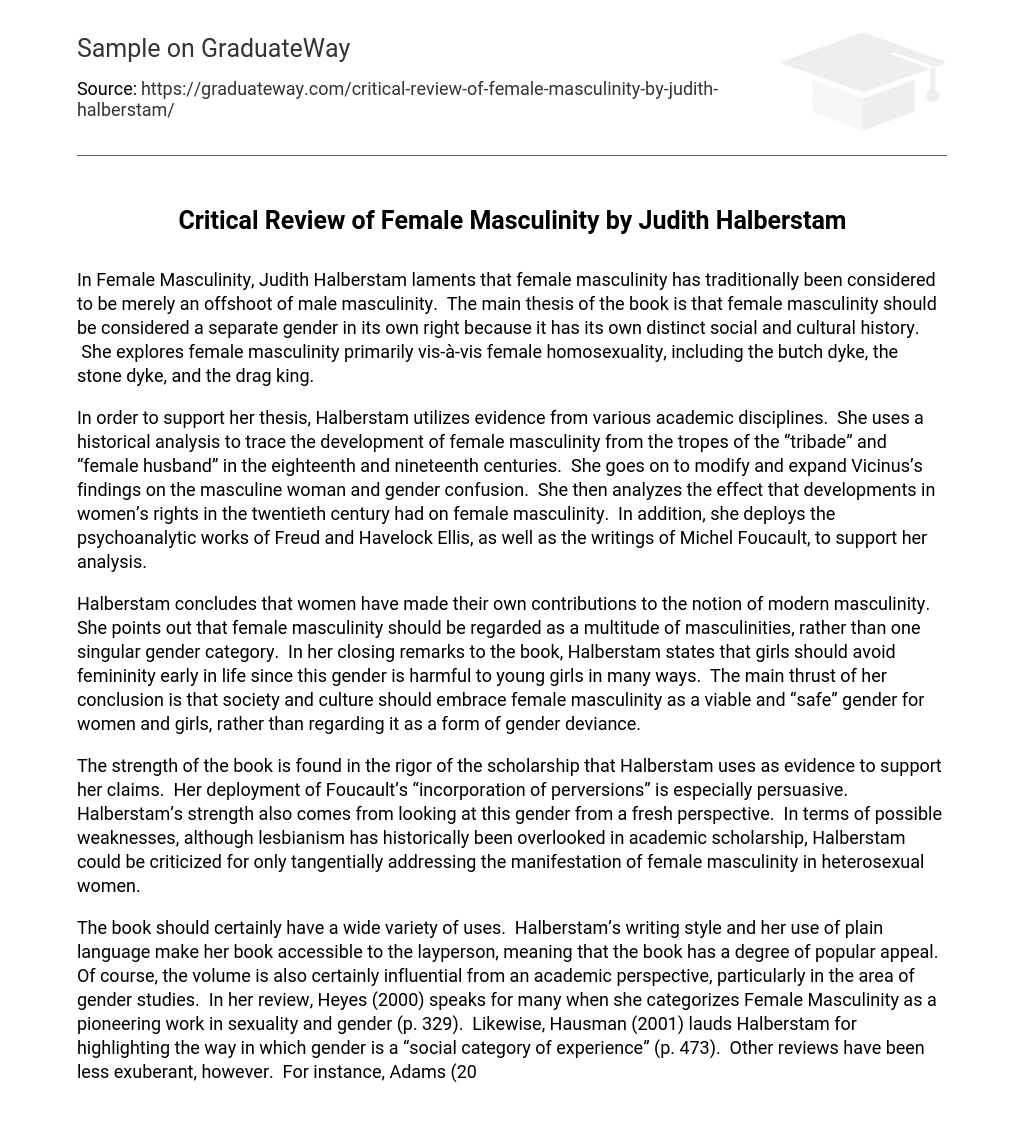In Female Masculinity, Judith Halberstam laments that female masculinity has traditionally been considered to be merely an offshoot of male masculinity. The main thesis of the book is that female masculinity should be considered a separate gender in its own right because it has its own distinct social and cultural history. She explores female masculinity primarily vis-à-vis female homosexuality, including the butch dyke, the stone dyke, and the drag king.
In order to support her thesis, Halberstam utilizes evidence from various academic disciplines. She uses a historical analysis to trace the development of female masculinity from the tropes of the “tribade” and “female husband” in the eighteenth and nineteenth centuries. She goes on to modify and expand Vicinus’s findings on the masculine woman and gender confusion. She then analyzes the effect that developments in women’s rights in the twentieth century had on female masculinity. In addition, she deploys the psychoanalytic works of Freud and Havelock Ellis, as well as the writings of Michel Foucault, to support her analysis.
Halberstam concludes that women have made their own contributions to the notion of modern masculinity. She points out that female masculinity should be regarded as a multitude of masculinities, rather than one singular gender category. In her closing remarks to the book, Halberstam states that girls should avoid femininity early in life since this gender is harmful to young girls in many ways. The main thrust of her conclusion is that society and culture should embrace female masculinity as a viable and “safe” gender for women and girls, rather than regarding it as a form of gender deviance.
The strength of the book is found in the rigor of the scholarship that Halberstam uses as evidence to support her claims. Her deployment of Foucault’s “incorporation of perversions” is especially persuasive. Halberstam’s strength also comes from looking at this gender from a fresh perspective. In terms of possible weaknesses, although lesbianism has historically been overlooked in academic scholarship, Halberstam could be criticized for only tangentially addressing the manifestation of female masculinity in heterosexual women.
The book should certainly have a wide variety of uses. Halberstam’s writing style and her use of plain language make her book accessible to the layperson, meaning that the book has a degree of popular appeal. Of course, the volume is also certainly influential from an academic perspective, particularly in the area of gender studies. In her review, Heyes (2000) speaks for many when she categorizes Female Masculinity as a pioneering work in sexuality and gender (p. 329). Likewise, Hausman (2001) lauds Halberstam for highlighting the way in which gender is a “social category of experience” (p. 473). Other reviews have been less exuberant, however. For instance, Adams (2007) remarks that it is unfortunate that men and masculinity have once again become the focus of scholarly debate (p. 1).
The criticisms of Halberstam’s book perhaps stem from certain biases and conflicts that are present in her work. Entitling the volume Female Masculinity, Halberstam initially appears to be biased towards essentialism by ostensibly assuming that “female” and “masculine” are given and predetermined. Yet, a great many of Halberstam’s arguments in the book inherently rely upon the binary logic of social constructivism, particularly on the view that “femininity” is a socio-cultural artifice that is thrust upon women unwillingly.
My reaction to the book was mixed. Upon reading the first few pages, I feared that the book would be technical and difficult. After finishing the first chapter, however, I realized that the book was going to be quite easy to read. The historical information helped to foreground Halberstam’s arguments and made the book more interesting. I was particularly fascinated with the analysis of the androgyne in Chapter 2 of the book. Perhaps the most positive aspect of reading the book for me personally was that Halberstam’s analyses shed light on my own gender behavior. Indeed, on several occasions I found myself identifying with her comments.
References
Adams, R. (2007). Masculinity without men: review of Judith Halberstam, Female Masculinity. Retrieved April 2, 2007 from http://www.columbia.edu/itc/english/adams/g6651-001-x01/HalberstamReview
Hausman, B. L. (2001). Recent transgender theory. Feminist Studies, 27, 465-490.
Heyes, C. J. (2000). Female Masculinity review. NWSA Journal, 12, 329.





